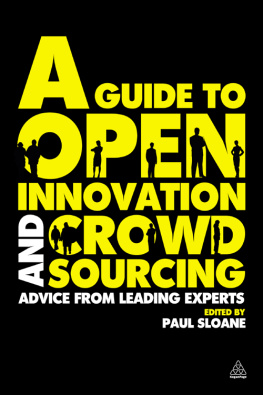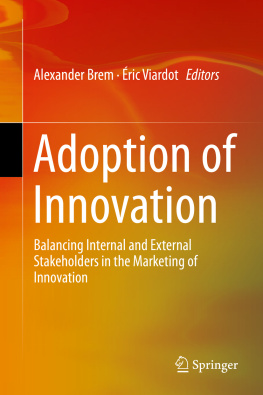The Long Tail of Expertise
Alpheus Bingham and Dwayne Spradlin
We sold more books today that didn't sell at all yesterday than we sold today of all the books that did sell yesterday.
Josh Petersen, Amazon employee
Overview
Whoever thought the power function would become an icon of popular culture? Chris Andersons and Clay Shirkys terrific writings have achieved just that. The power function, once relegated to workhorse status in statistics, mathematics, and modeling, now graces the cover of popular books and appears in hip, trendy magazines. Its newfound status results in the ease in which it explains the market phenomenon of businesses such as Amazon.com.
The Long Tail concept has found applications in marketing, inventory strategy, Internet statistics, research, and media sales. It is invoked here, qualitatively, as a means to illustrate some observations made on a daily basis at InnoCentive and which are more broadly applicable to innovation in general and the entire notion of expertise. Step one is for you to have a clear picture of the image in mind as the arguments are discussed. A power function plot, with its long tail is shown in .
Figure 1A plot of a power function showing the very long tail that approaches, but never quite reaches, the baseline as it extends forever to the right.

For the moment, concentrate only on the curved gray line that swoops down from the upper left and disappears off the chart on the lower right. The right portion of this curve is what has been referred to as the long tail. For this discussion, the left side will be called the head, in contrast to the tail. Using the bookselling example, you can label the y-axis sales volume (or popularity if you prefer). And the x-axis would be simply each book in the world arrayed from most popular on the left to least popular on the right, at that point in time. The head of this curve would thus contain those books on The New York Times bestseller list, and anything mentioned on the Oprah Winfrey show. If you are a small bookseller and have room for only 100 titles, naturally you would want the 100 books represented on the leftmost part of this curvefor the simple reason that they would generate more revenue per inch of shelf space than any other 100 books. The point made by Anderson and the long tail argument is this: On any given day, customers are more likely to want to purchase more books from the hundred-and first-popularity on down than they are books among the 100 most popular. But because you don't know precisely which of those less popular books are likely to be purchased that day, you can never make a rational stocking decision other than the one already made, which is to stock the most popular books.
These arguments are, at the same time, obvious and subtle. Businesses make such rational choices all the time, and because of their obviousness, their subtlety is never examined.
Defining and Hiring Experts
Most people feel that they are quite clear on their definition of what qualifies someone to be called an expert. It is easy for them to say that Stephen Hawking is an expert in cosmology and I am not, that Jared is an expert woodworker and I am not, that I am an expert chemist and Dwayne is not, and that Dwayne is an expert mathematician and I am not. Such statements feel well-defined and easily justifiable on the basis of degrees, training, experience, publications, and contributions. But, even as I exclude myself from the category of expert plumbers, I would argue that, although I know less than those experts, I do know more than many other people. And there are those who know more than me but may not quite reach the level of expert.
Recognizing the continuous nature of these definitions, you can realize that no boundary line exists and that experts merge seamlessly with novices and even those who can be described only as totally ignorant on the subject of plumbing.
The first reaction to an argument like this is understandably, So what? So what if it's a continuum; so what if you have to draw some arbitrary line? So what if you make the measured decision to use your neighbors Saturday plumbing skills to put in a new sink instead of hiring an enormously qualified, and probably overpaid, expert? Baseball pitching skills probably follow the same continuous pattern, and the Yankees are content to look for the pitcher residing on the leftmost of the curve and offer him a sufficient salary to entice him to join the team.
All hiring decisions are generally presented as if it were no more complex than the recruiting of a new pitcher or making that Saturday afternoon plumbing choice. But in the case of full-time permanent employment offers, it is often quite a bit murkier. One typically frames the recruiting process in those same simple terms: Find me a top grade CEO, Find me an expert electrical engineer, or Find me an outstanding market analyst. But the commitment of hiring a permanent employee is actually quite different. You might even have an immediate situation driving your choice. Perhaps a new CEO is needed to help enter a new market sector or to manage through an explosive period of growth. Perhaps an electrical engineer is needed to debug stray radio frequency signals that are compromising a new product release. And perhaps a market analyst is needed to immediately prepare reports on newly acquired telecom capabilities. But it is almost invariably true that if these individuals are hired, they will remain with the organization after, sometimes long after, those immediate needs are satisfied.
Executives, human resource departments, and recruiters are smart enough to recognize that they are seeking a broader sort of individual, one who can solve not only the issues of immediate concern but also the issues, appropriate to their expertise, that will surface in the future. Unfortunately, because these are issues and challenges that haven't surfaced yet, they cannot be named, and they cannot be specifically recruited for. And thus, the practical consequence of expertise within the business world becomes awkwardly defined as the ability to solve a domain-specific problem posed in the future. It's not a real crisp definition; it's not a definition you would look forward to building metrics around. It's just the practical reality of what you're actually doing when you hire someone.
You hire an editor because you believe she will do a good job of editing manuscripts that haven't been written yet; you hire a chemist because you believe she will do a good job of synthesizing compounds, that not only do not exist yet, but also which, at present, you do not even know you want; and you hire a bookkeeper to compute unmade sales, unmade costs, and use reporting rules yet unwritten by accounting standards bodies.
So how, exactly, can you measure a job candidates fitness for a future need? The answer to this question relates to a quote about gambling and horse racing: "The race is not always to the swift, nor the battle to the strong, but thats the way to bet." Employers are placing bets on employees, and their recruitment filters are designed to identify "the swift and the strong." Is that not what a race handicapping system is designed to do? It is designed to use measurements that can be made today to enable you to predict the horse and jockey that will win tomorrow. The values that can be measured today, such as recent track times, health, weight, experience, and so on, are not the values crucial to your success; that is, all you really want to know at the moment it counts is, Did the horse win? Those other properties you measure aren't what you actually











